I. Introduction
Egyptian mythology, a rich tapestry woven with intricate symbols, enigmatic gods, and compelling narratives, invites us into a world where the ancient civilization breathed life into stone and scripture. Among this pantheon, Nut, a sky goddess, weaves an enigmatic narrative that transcends time. Often overshadowed by deities like Ra and Isis, Nut’s ethereal presence paints a narrative of celestial harmony and earthly discord, a dance between the heavens and earth. This article aims to unveil the enigmatic allure of Nut, an emblem of the night sky adorned with stars, a protector and nurturer, echoing the ancient Egyptians’ complex cosmology. We embark on an explorative journey to unfold the nuances of Nut’s identity, contributions, and significance in the intricate world of Egyptian mythology, drawing insights from ancient texts, artifacts, and the silent testimonies of the architectural marvels that bear witness to her enduring legacy.
| Origin | Ancient Egyptian Civilization |
|---|---|
| Classification | Goddess |
| Family Members | Shu (Father), Tefnut (Mother), Geb (Brother/Husband), Osiris, Isis, Seth, Nephthys (Children) |
| Region | Egypt |
| Associated with | Sky, Stars, Heavens, The Universe, Astronomy, Renewal |
II. Nut’s Historical Context
Origins:
The annals of history, carved in the intricate hieroglyphs adorning ancient monuments and whispered through the parchments of time-honored texts, hold the first murmurs of Nut’s existence. Our journey back in time unearths Nut’s silent emergence in the Pyramid Texts, one of the oldest known religious texts in the world. In these sacred writings, we encounter a goddess of the skies, a celestial entity whose body, bespeckled with stars, arched over the earth to embrace the horizon.
Immersing in the artistry of ancient Egyptian artisans, we observe Nut’s depictions highlighting her as an emblem of protection and sustenance. The artwork carved into the stones of tombs and temples portray the goddess with outstretched wings, a testament to her all-encompassing embrace that encapsulated the earthly realm.
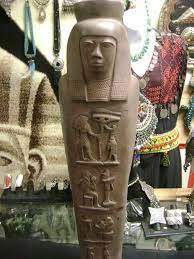
Role and Significance:
Nut’s significance within the Egyptian pantheon is multifaceted, intertwining the earthly and celestial realms. Her prominence is not merely a reflection of her celestial grandeur but extends into the foundational myths that underpin ancient Egyptian cosmology. Nut stands as a guardian, her body a sanctuary where the sun finds refuge each evening, only to be rebirthed at dawn.
The creation myths echo with Nut’s narrative, illuminating her separation from her consort Geb, the earth god, by the command of the sun god Ra. This eternal separation marks the birth of the cosmos, the heavens arcing gracefully away from the earthly expanse, establishing the order of the universe.
Nut’s protective essence is further underscored in her role as a shield against the forces of chaos. The goddess’s nightly journey across the sky, her body glittering with stars, wasn’t a mere celestial dance but a combat against the darkness, ensuring the triumphant return of the sun each dawn.
III. Nut’s Mythological Narratives
Cosmology:
The celestial ballet, where Nut pirouettes as the star-strewn sky, narrates a cosmic symphony of harmony and grandeur. Each star adorning her body is a sonnet, echoing the ancient Egyptians’ complex yet harmonious worldview. Nut isn’t merely a spectator in this cosmic dance but the very canvas where the sun, moon, and stars paint the rhythmic cycles of time. Each dawn witnessed the rebirth of the sun from Nut’s tender embrace, an emblem of renewal and cyclical harmony.
Nut’s representation as the sky is an intricate blend of artistic expression and theological sophistication. She’s not just a visual spectacle but an intrinsic entity intertwining the physical and metaphysical realms. The detailed artifacts, resplendent with depictions of Nut, portray her body arched in a protective stance, underscoring the ancients’ perception of the cosmos as a dynamic, sentient entity.
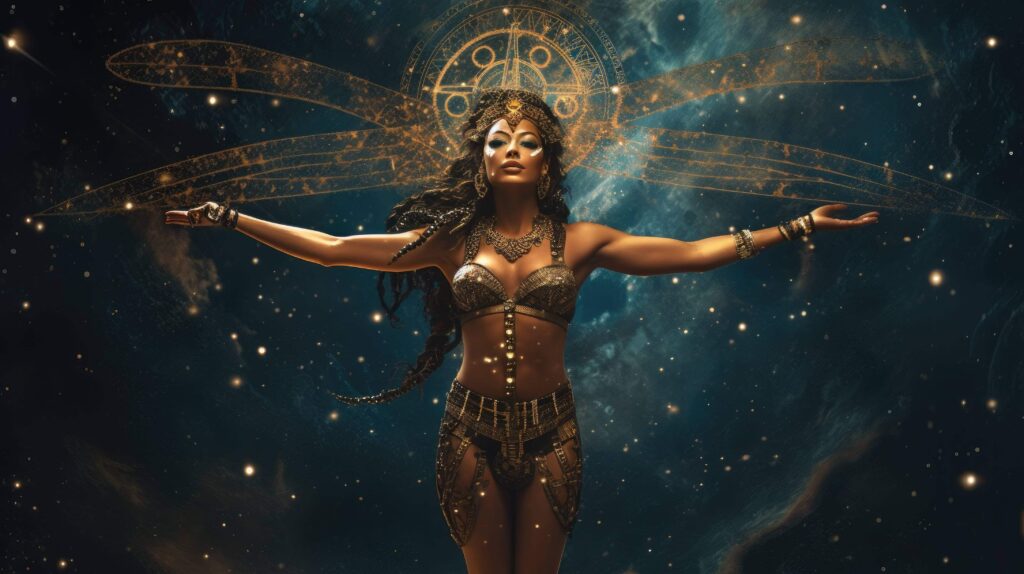
Family Ties:
In the intricate weave of Egyptian mythology, Nut’s familial ties unfold narratives of passion, power, and prophecy. She is intrinsically linked to Geb, the Earth god – a union symbolizing the eternal dance between the earth and sky. The legends echo with the poignant separation of Nut and Geb, an edict of the sun god Ra, ensuing in the birth of the cosmos.
Nut is also the revered mother of illustrious deities – Osiris, Isis, Seth, and Nephthys. Each offspring contributes to the multifaceted narrative of Egyptian mythology. Osiris’s resurrection, Isis’s magical prowess, Seth’s turbulence, and Nephthys’s protective aura – every narrative is a strand weaving Nut into the intricate tapestry of myths that have transcended millennia.
Myths and Legends:
Nut’s mythological journey is not linear but a cyclical odyssey echoing the eternal rhythms of the cosmos. One of the most poignant myths elucidates Nut’s separation from Geb. This separation, decreed by Ra, was mitigated by the wisdom of Thoth, the god of wisdom, who created five additional days, breaking the cycle of the 360-day calendar. Nut gave birth to her illustrious children during these days, marking a narrative of defiance, wisdom, and creation.
Nut’s nightly sojourn across the sky, a star-studded odyssey, narrates a combat against chaos and darkness. Every dawn heralds her victory, a testament to the eternal dance of order and chaos, light and darkness, creation and dissolution – central tenets encapsulating the essence of ancient Egyptian cosmology.
IV. Iconography and Symbolism
Visual Representation:
The graceful arch of Nut’s body across the ancient Egyptian skyline is not a mere artistic illustration but a profound symbolic narrative embodying celestial mysteries. Each curve, star, and hue painted or carved into the enduring edifices of temples and tombs unveils a layer of the enigmatic sky goddess’s identity. Nut is often depicted as a woman, her body a serene expanse where the golden sun sets and the silvery moon rises, each star a silent testament to the cosmic dances unfolding in the silent spaces of the nightly heavens.
In the intricate paintings gracing the tombs of pharaohs, Nut is a guardian. Her outstretched wings, adorned with stars, echo the ancients’ belief in her protective embrace. She is the silent sentinel warding off chaos, her body a fortress where the departed souls find sanctuary and the sun god retreats to be reborn at dawn. Every hue, stroke, and form encapsulates theological insights, cosmic cycles, and the mystical dance between the earthly and celestial realms.
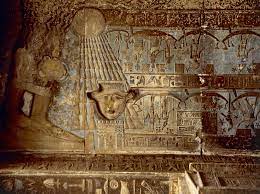
Temples and Sacred Sites:
As we tread the silent corridors of temples echoing with whispers of a time where gods walked among men, the sacred sites associated with Nut unfold narratives etched in stone and time. One such architectural marvel is the Temple of Dendera. Each column, inscription, and artifact within this sacred edifice is a testament to Nut’s enduring presence. Here, the ceiling adorned with exquisite paintings unveils Nut’s nightly journey, a celestial dance narrated through intricate iconography and symbolic motifs.
Original photographs and descriptions elucidate the nuanced narratives unfolding in the silent spaces of these sacred edifices. Each image captures Nut’s iconographic representations, the detailed carvings and inscriptions breathing life into myths echoing with the rhythms of the cosmos.
V. Nut’s Legacy in Contemporary Culture
Modern Interpretations:
In the contemporary epoch, the enigmatic Nut emerges from the ancient texts and temple walls, finding resonance in the ongoing dialogues of Egyptologists, mythologists, and enthusiasts around the globe. The modern interpretations of Nut are a fascinating amalgamation of academic insights, artistic expressions, and popular culture narratives.
Leading Egyptologists lend their voices to the ongoing discourse, unearthing nuances from the ancient scripts, artifacts, and architectural marvels bearing the silent testimonies of Nut’s enduring saga. In the academic corridors, Nut transforms from a mythical figure to a subject of intricate studies, each research paper, and analysis unveiling layers of her celestial and earthly dances.
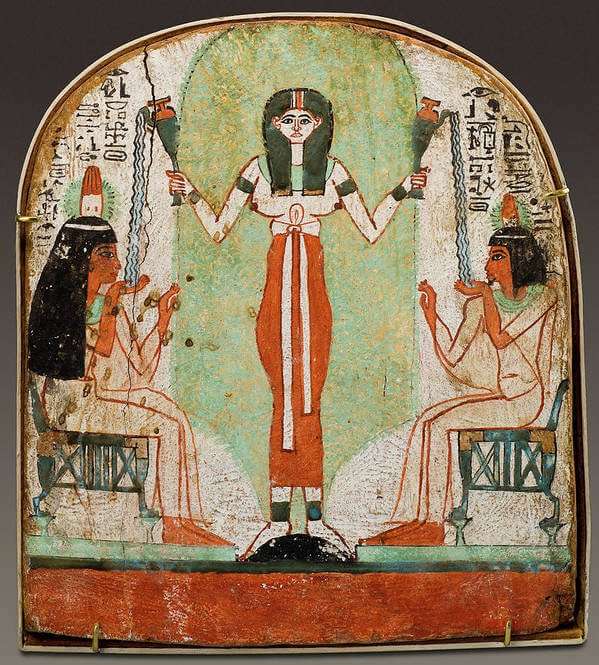
Her star-studded journey across the nightly heavens finds poetic expressions in contemporary literature, where authors and poets are inspired by the silent sonnets whispered by the stars adorning Nut’s eternal embrace. The modern renditions, though distinct, echo with the ancient allure, a testament to Nut’s timeless enigma.
Cultural Influence:
Nut’s celestial symphony transcends the epochs, finding echoes in contemporary art, literature, and cultural expressions. In the world of art, painters and sculptors draw inspiration from Nut’s iconic imagery, her body arched in a protective embrace, a canvas where the nightly heavens unfold their silent narratives.
In literature, Nut’s myths weave through the pages of novels, poetry, and essays. Authors, inspired by the ancient texts, breathe life into Nut’s narratives, each word a silent echo of the celestial dances witnessed by the ancients. The digital era, marked by the virtual spaces where myths and legends find a new abode, is replete with online forums, social media platforms, and digital art spaces where Nut’s legacy is revisited, reinterpreted, and relived.
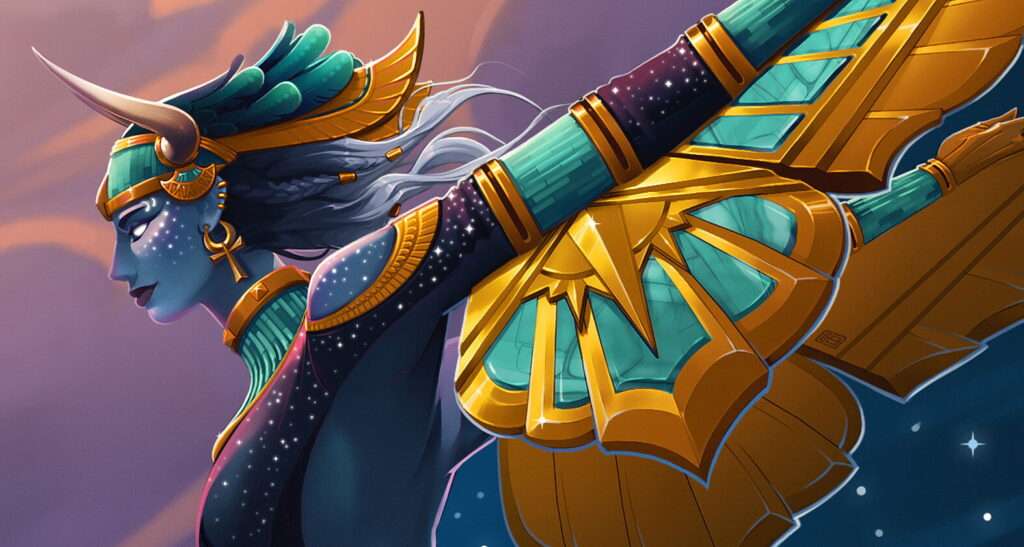
Each brush stroke, poetic verse, and digital expression is a testament to Nut’s enduring legacy. The sky goddess, though rooted in the ancient epochs, finds her narratives resonating in the contemporary spaces, echoing the timeless allure of the mystical dances between the earth and heavens, the mortal and divine, the tangible and ethereal.
VI. Conclusion
In the rich tapestry of narratives, artifacts, and insights unveiled, Nut emerges as a celestial enigma, weaving the earthly and cosmic realms into a harmonious dance. We traced her silent whispers in ancient texts, marveled at her grandeur in historical edifices, and encountered her enduring legacy in contemporary cultural expressions. Nut, with her star-adorned embrace, unfolds a narrative of protection, creation, and cosmic harmony. As we step back, a contemplative silence echoes the profound mystery that still shrouds this ancient deity. Each artifact, text, and modern interpretation is a thread weaving Nut’s enigmatic allure, inviting future generations into a celestial dance where myths, histories, and cultural expressions intertwine, echoing the timeless rhythm of an ancient civilization’s cosmic symphony.
